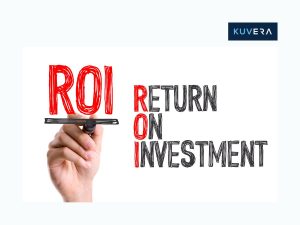What is ROI?
Return on investment, or ROI, is a measure of the profitability of an investment. It is calculated by dividing the net profit of the investment by the cost of the investment, and it is usually expressed as a percentage. For example, if an investment generates a net profit of $100 and the cost of the investment was $500, the ROI would be 100/500 = 0.20, or 20%. ROI is a useful metric for evaluating the performance of an investment and for comparing the potential returns of different investments. However, it is important to note that ROI is only one factor to consider when making investment decisions, and it should be used in conjunction with other information about the investment.
How to calculate ROI?
To calculate the ROI of an investment, you need to know the net profit of the investment and the cost of the investment. The net profit is the total income generated by the investment, minus any expenses or losses associated with the investment. The cost of the investment is the amount of money that was initially invested in the investment. Once you have these numbers, you can calculate the ROI by dividing the net profit by the cost of the investment and multiplying the result by 100 to express it as a percentage. For example, if an investment generated a net profit of $100 and the cost of the investment was $500, the ROI would be calculated as follows:
ROI = (Net profit / Cost of investment) x 100
ROI = ($100 / $500) x 100 = 20%
In this example, the ROI of the investment is 20%.
Limitations of ROI
While ROI is a useful metric for evaluating the performance of an investment, it has several limitations that investors should be aware of. One of the main limitations is that it only considers the net profit and the cost of the investment, and it does not take into account other factors that may affect the investment, such as the riskiness of the investment or the length of time the investment was held. As a result, investments with different levels of risk or different holding periods may have the same ROI, even though they may not be equally attractive to investors. Additionally, it only considers the financial return of the investment and it does not take into account other potential benefits, such as the social or environmental impact of the investment. Finally, ROI is only relevant for investments that have been completed, and it cannot be used to evaluate the potential performance of an investment that is still ongoing.
Types of ROI
There are several different types of return on investment, including:
Net ROI: This is the most commonly used type of ROI, and it is calculated by subtracting the total costs of an investment from the total returns, and then dividing the result by the total costs.
Gross ROI: This type of ROI is calculated by dividing the total returns of an investment by the total costs, without subtracting the costs from the returns.
Return on equity (ROE): This is a measure of the profitability of a company, calculated by dividing the net income by the shareholder’s equity.
Return on assets (ROA): This is a measure of the profitability of a company, calculated by dividing the net income by the total assets.
Return on capital employed (ROCE): This is a measure of the profitability of a company, calculated by dividing the operating profit by the capital employed.
Return on investment in marketing (ROMI): This is a measure of the efficiency of marketing investments, calculated by dividing the incremental revenue generated by the marketing activities by the cost of the marketing activities.
Internal rate of return (IRR): This is a measure of the profitability of an investment, calculated by finding the discount rate that makes the net present value (NPV) of the investment equal to zero.
Payback period: This is a measure of the time it takes for an investment to recover its costs. It is calculated by dividing the initial investment by the annual cash flows generated by the investment.
Discounted cash flow (DCF) return: This is a measure of the profitability of an investment, calculated by discounting the expected cash flows from the investment at a rate that reflects the time value of money and the level of risk associated with the investment.
What is a good ROI?
The definition of a “good” ROI can vary depending on a number of factors, such as the type of investment, the industry in which the investment is made, and the individual investor’s risk tolerance and investment goals. In general, however, a good ROI is typically considered to be one that is higher than the average return for the given industry or market. For example, if the average return for a particular industry is 10%, an investment with an ROI of 15% may be considered to be a good one. It is important to note, however, that a high ROI does not necessarily guarantee the success or profitability of an investment, and investors should always carefully evaluate the potential risks and rewards of any investment before making a decision.
Interested in how we think about the markets?
Read more: Zen And The Art Of Investing
Check out all our “Investor Education Originals” videos on Youtube and get smart about investing
#MutualFundSahiHai #KuveraSabseSahiHai












